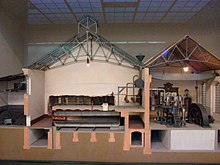Tullnau power plant
The Tullnau power plant was the first power plant in Nuremberg . It was opened in 1895 and shut down in 1913 with the commissioning of the large Franken power station . Parts of the buildings still exist today.
history
As early as 1882, the Nuremberg electrical pioneer Sigmund Schuckert installed Germany's first permanent electric street lighting on Josephsplatz and Kaiserstrasse.
In 1893 Oskar von Miller was commissioned to develop a concept for a public power supply. In February 1894, the city council chose the newly developed alternating current technology from several variants . This made it possible to supply the entire urban area at that time from a central power station. The Schuckert company received the order on March 2, 1895, and the plant went into operation in March 1896. The construction costs amounted to 1.2 million marks. In the following years, the sudden increase in demand required repeated expansions up to a good fourfold.
At the same time established Nuremberg-Fürth tram own electrical power station for the driving power supply with direct current of 500 V . This power plant was expanded from 480 kW when it was commissioned in 1896 to 1220 kW in 1900.
technology
The power station was run on coal. The Tullnau location was well suited because the supply of coal was guaranteed by the neighboring railway lines , enough water was available to feed the steam boiler and there was space for later expansions. The power plant initially had three single-phase AC machines from Schuckert of 230 kW each, i.e. a total of 690 kW. The three steam engines from MAN each had an output of 500 hp . The network was fed with 2,000 V.
The heavy current department of the Deutsches Museum in Munich highlights the power plant as an example of early alternating current electrification. A cutaway model shows the state of commissioning, a display board shows its history and the distribution network within Nuremberg.
A fourth machine set was ordered during the construction phase, which increased the output to 920 kW. At the end of 1896, 1,102 pantographs were already connected, operating 26,955 incandescent lamps, 545 arc lamps and 123 motors. Through further expansions, the total output finally reached 3,050 kW from 1900.
Decommissioning and reuse
The two Nuremberg power stations were ultimately no longer able to meet the increasing demand. Therefore the city of Nuremberg (with 51% of the shares), Fürth (23%) and the Elektrizitäts-Aktiengesellschaft formerly Schuckert & Co. (26%) founded the Großkraftwerk Franken AG in 1911 . After the commissioning of their power plant in Gebersdorf on April 19, 1913, the two Nuremberg power plants were shut down. After the first expansion stage in 1914, the new power plant had more than 24,000 kW of power to centrally supply large parts of Middle Franconia.
The buildings in Tullnau continued to be used by the Nuremberg Municipal Works for operational purposes. Among other things, the "Cable Museum " was located here, a collection of the history of technology that has meanwhile been handed over to the Museum of Industrial Culture.
In the course of the development of the Tullnau Park , during which the neighboring dairy farm was demolished despite the monument protection, the investor Dibag also acquired the power station. The entire system of an early power station, which had been structurally preserved until then, is not a listed building. The boiler house, head building, dynamo hall and service residential building were demolished in 2011, only the dynamo hall remained. It was renovated and converted for today's use by a kindergarten and a restaurant.
literature
- Manfred Hahn: 100 years of electricity in Franconia . wek-Verlag Treuchtlingen, Berlin 2014. ISBN 978-3-934145-94-8 . Page 25 ff.
- Siegfried Kett: Enlightenment and Acceleration. Nuremberg's role in electrical history. Schrenk Verlag Röttenbach 2016. ISBN 978-3-924270-83-4 . Page 146 ff.
- Steven M. Zahlaus: The Tullnau (Part II): More light! - The first municipal power station in Nuremberg . in: Norica. Reports and topics from the Nuremberg City Archives 12 (2016), ISSN 1861-8847
Web links
- Nuremberg's first power station on www.nuernberginfos, de (private website)
- Nuremberg-Tullnau power station . Post from February 11, 2011 in the blog Faces of the City with good photos of the state of 2011.
Individual evidence
- ↑ a b c Manfred Hahn: 100 years of electricity in Franconia . wek-Verlag Treuchtlingen, Berlin 2014. ISBN 978-3-934145-94-8 . Page 25 ff.
- ^ Robert Binder: City traffic in Nuremberg and Fürth from 1881 to 1981 , VAG Verkehrs-Aktiengesellschaft Nürnberg 1986, page 34 ff.
- ↑ Development of AC and three-phase current technology on the website of the Deutsches Museum
- ↑ Manfred Hahn: 100 years of electricity in Franconia . wek-Verlag Treuchtlingen, Berlin 2014. ISBN 978-3-934145-94-8 . Page 80 ff.
- ↑ Nuremberg's first power station at www.nuernberginfos, de (private website)
- ^ Start of construction in Tullnau , Nürnberger Zeitung of November 17, 2011
- ↑ The future of the E-Werk in Tullnau is secured , nordbayern.de of March 11, 2014
- ↑ Das Spielzeughaus , article in the Nürnberger Stadtanzeiger from March 11, 2017 about the renovation as a PDF with photos on the website of the architects Hübsch + Harlé
Coordinates: 49 ° 26 '58.9 " N , 11 ° 6' 11.6" E




